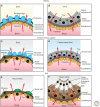Directional Fluid Transport across Organ-Blood Barriers: Physiology and Cell Biology
- PMID: 28003183
- PMCID: PMC5334253
- DOI: 10.1101/cshperspect.a027847
Directional Fluid Transport across Organ-Blood Barriers: Physiology and Cell Biology
Abstract
Directional fluid flow is an essential process for embryo development as well as for organ and organism homeostasis. Here, we review the diverse structure of various organ-blood barriers, the driving forces, transporters, and polarity mechanisms that regulate fluid transport across them, focusing on kidney-, eye-, and brain-blood barriers. We end by discussing how cross talk between barrier epithelial and endothelial cells, perivascular cells, and basement membrane signaling contribute to generate and maintain organ-blood barriers.
Copyright © 2017 Cold Spring Harbor Laboratory Press; all rights reserved.
Figures




Similar articles
-
The blood-brain and the blood-cerebrospinal fluid barriers: function and dysfunction.Semin Immunopathol. 2009 Nov;31(4):497-511. doi: 10.1007/s00281-009-0177-0. Epub 2009 Sep 25. Semin Immunopathol. 2009. PMID: 19779720 Review.
-
Structure and Junctional Complexes of Endothelial, Epithelial and Glial Brain Barriers.Int J Mol Sci. 2019 Oct 29;20(21):5372. doi: 10.3390/ijms20215372. Int J Mol Sci. 2019. PMID: 31671721 Free PMC article. Review.
-
Development and Cell Biology of the Blood-Brain Barrier.Annu Rev Cell Dev Biol. 2019 Oct 6;35:591-613. doi: 10.1146/annurev-cellbio-100617-062608. Epub 2019 Jul 12. Annu Rev Cell Dev Biol. 2019. PMID: 31299172 Free PMC article. Review.
-
Brain iron homeostasis.Dan Med Bull. 2002 Nov;49(4):279-301. Dan Med Bull. 2002. PMID: 12553165 Review.
-
The Par3/Par6/aPKC complex and epithelial cell polarity.Exp Cell Res. 2013 Jun 10;319(10):1357-64. doi: 10.1016/j.yexcr.2013.03.021. Epub 2013 Mar 25. Exp Cell Res. 2013. PMID: 23535009 Review.
Cited by
-
Distinct roles for luminal acidification in apical protein sorting and trafficking in zebrafish.J Cell Biol. 2020 Apr 6;219(4):e201908225. doi: 10.1083/jcb.201908225. J Cell Biol. 2020. PMID: 32328632 Free PMC article.
-
Single-Cell RNA Sequencing Reveals Molecular Features of Heterogeneity in the Murine Retinal Pigment Epithelium.Int J Mol Sci. 2022 Sep 8;23(18):10419. doi: 10.3390/ijms231810419. Int J Mol Sci. 2022. PMID: 36142331 Free PMC article.
-
Phagocytosis by the retinal pigment epithelium: New insights into polarized cell mechanics.Bioessays. 2025 Jan;47(1):e2300197. doi: 10.1002/bies.202300197. Epub 2024 Dec 11. Bioessays. 2025. PMID: 39663766 Free PMC article. Review.
-
Stromal-Like Cells and Retinal Pigment Epithelium Modulate Choroidal Sprouting Through Galectin-1-Dependent and Independent Pathways.FASEB J. 2025 May 31;39(10):e70671. doi: 10.1096/fj.202403181R. FASEB J. 2025. PMID: 40407849
-
A Splicing Mutation in Slc4a5 Results in Retinal Detachment and Retinal Pigment Epithelium Dysfunction.Int J Mol Sci. 2022 Feb 17;23(4):2220. doi: 10.3390/ijms23042220. Int J Mol Sci. 2022. PMID: 35216333 Free PMC article.
References
-
- Abbott NJ. 2004. Evidence for bulk flow of brain interstitial fluid: Significance for physiology and pathology. Neurochem Int 45: 545–552. - PubMed
-
- Amorena C, Castro AF. 1997. Control of proximal tubule acidification by the endothelium of the peritubular capillaries. Am J Physiol 272: R691–R694. - PubMed
Publication types
MeSH terms
Grants and funding
LinkOut - more resources
Full Text Sources
Other Literature Sources
